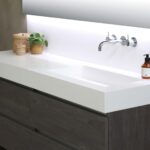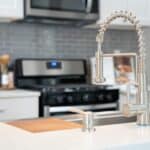This post may contain affiliate links. If you use these links to buy something we may earn a small commission. Thanks.
We’ve put together this guide comparing satin nickel vs brushed nickel faucet finishes to help make things easier for you when deciding which one fits your tastes better.
Choosing the right faucet finish can be tricky. There are so many to choose from, and it’s hard to know which one will fit your style best.
The two most popular bathroom finishes for faucets are satin nickel and brushed nickel.
Both satin nickel and brushed nickel have a unique look that can add flair to any bathroom decor. But which one is better for you?
If you’re planning a bathroom remodel, make sure to check our in-depth buyer’s guide about the best bathroom faucets.
Background: Brushed nickel is plated and brushed with a metal brush to give it a unique finish. An electrolysis process is used for satin nickel to achieve its look.
Satin Nickel vs Brushed Nickel Faucet Finish
Satin nickel isn’t technically a metal itself but a nickel-plated piece of metal with zinc or brass as a base to make it more appealing. It’s applied through electrolysis and may have additional coats for color or shine before being lacquered to dull nickel’s usually shiny surface.
On the other hand, brushed nickel is plated with nickel and then brushed with a metal brush to give it a unique finish. Similar to satin nickel, brushed nickel also goes through an electrolysis process to get a modern look.
We’ve put together the following comparison to help you understand the differences between satin nickel vs brushed nickel faucet finish.
Type of Plating/Finish
In terms of appearance, the satin nickel finish has a dull finish with an even, non-reflective texture. This type of plating hides blemishes and makes your faucets look cleaner. You can get a satin nickel faucet finish in either dark matte or semi-matte finishes.
Brushed nickel has a subtle, softer-looking finish with a slightly brushed appearance. It is often confused with stainless steel, so it can tie in nicely with other stainless steel appliances.
However, brushed nickel is infamous for showing fingerprints, scratches, and water spots that require regular cleaning.
Brushed nickel is usually available in brushed brown or gray metallic—both come with a non-uniform type of finish.
Tint
Satin Nickel is a warm, grey color with just the right amount of rose gold tint and visible brush marks on its surface. Architects and designers love satin nickel because it’s softer than other materials while still being very modern-looking. This type of finish also works well in kitchens and bathrooms where you want an industrial feel without harshness.
Brushed nickel tends to have a golden or brownish tint with a nice gray finish. It has a textured look and a warm tone that creates an intriguing interaction of light and shadow on the metal’s surface. Brushed nickel is the perfect choice if you are going after earth tones or warm colors.
Corrosion Resistance and Durability
Satin nickel is slightly more corrosion-resistant than brushed nickel because it has a lower zinc content. However, they are durable enough to withstand the wear and tear of daily use and can be cleaned with water or mild soap.
Brushed nickel typically lasts up to 10 years before needing to be replaced, while satin nickel usually lasts longer.
The downside to brushed nickel is that it can show tarnishing and corrosion over time. If you need a faucet that will last, then satin nickel or stainless steel may be better for you. There are definitely some ways to keep brushed nickel faucets from spotting.
Ability to Hide Fingerprints and Watermarks
Brushed nickel is known to show fingerprints and smudges more than satin nickel.
While you need to clean brushed nickel regularly, you may be able to get away with not cleaning your satin nickel faucet for a few days. But after that, you’ll need to wipe it down with a microfiber cloth or other soft material.
You can clean the surface of your satin nickel faucet without fear of damaging the material. Conversely, you should avoid using abrasive cleaners on your brushed nickel faucet to prevent scratches and damages that can’t be repaired.
Maintenance
Satin nickel faucets don’t require a lot of effort to maintain. You can use regular soap and water to keep them clean. However, if you want to keep your faucet shining like new, make sure to wipe it down with a soft cloth after every use.
Brushed nickel faucets tend to show streaks and watermarks. You may need to wipe them down with a wet cloth to remove the water stains, but it’s still not as easy as cleaning a satin nickel.
Application
Satin nickel and brushed nickel faucets can be used with different looks, but they work best with modern designs.
Satin nickel is usually common in residential hardware and bathrooms. Brushed nickel, on the other hand, is more prevalent in restaurants and commercial bathrooms.
Cost
Satin nickel and brushed nickel are often quite similar in price. However, in general, you’ll notice that brushed nickel fixtures are more expensive.
The finish may be included as a secondary feature for some brands at an additional cost. Manufacturers generally exclude the extra finishing treatment from the total cost of their prices.
Brushed nickel can cost a little more than satin nickel because it requires a lot more effort to create.
Mixing Satin and Brushed Nickel
If you’re confused between satin and brushed nickel but love both finishes, you can mix both of them in your rooms. It’s common to see these two used in the same settings because they complement each other well.
A brushed nickel finish light fixture may be followed by a satin nickel handle or vice versa to balance the fixture’s overall look. This is also an ideal choice for homeowners who want modern fixtures but are concerned about the high cost of brushed nickel.
This type of arrangement also works well with cabinets and countertops that have a contrasting tone.
FAQ
Yes, brushed nickel is good to be used for faucets. In fact, it is one of the most popular finishes these days since it matches nicely with most other accessories and fixtures in your bathroom or kitchen.
Some satin nickel finishes use an additional coat of lacquer that adds shine to an otherwise dull base. While satin finishes are known to be matte, some manufacturers have started using a mirror-like lacquer treatment that results in a glossier finish which causes some satin finishes to look shinier than others.
No. Nickel plating is a coating applied to stainless steel and other types of metals and is composed of nickel and chromium.
In general, nickel-plated finishes are less durable and prone to showing more defects than stainless steel. On the other hand, stainless steel does not rust and works best for heavy-use kitchens, but it can be susceptible to corrosion.
Satin Nickel vs Brushed Nickel Faucet Finish: Which is Better?
To sum up, satin nickel and brushed nickel faucets both have their benefits, but it really depends on your personal preference.
Satin nickel is usually preferred over brushed nickel because of its low maintenance, ease of cleaning, and hiding fingerprints and watermarks.
Moreover, it is relatively affordable and more suitable to be used in residential hardware.
Brushed nickel is excellent for a commercial/public place or bathroom with a warm color scheme. It gives a more unique, crafted look due to the etchings which everyone around you will love.
You can always mix both finishes together to create your ideal look without breaking the bank.
We hope you found this article helpful! If you have any questions or additional thoughts about brushed nickel vs satin nickel faucets, please leave a comment below.
Take a look at our best kitchen faucets if you’re planning on getting a new one!
Also Read: Brushed Nickel vs Chrome Faucets Finish or Brushed nickel vs stainless steel faucets.


